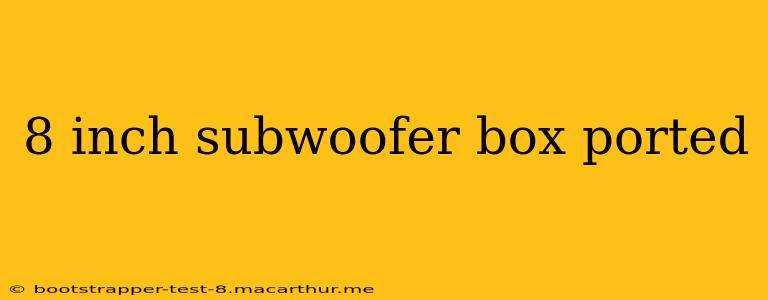Building a ported enclosure for your 8-inch subwoofer can significantly enhance its performance, delivering deeper bass and increased output. However, designing the right box requires careful consideration of several factors. This guide will walk you through the process, answering common questions and helping you build a high-performing system.
What is a Ported Subwoofer Enclosure?
A ported (or bass-reflex) enclosure uses a port—a precisely sized tube—to reinforce the subwoofer's output at specific frequencies. The port works in conjunction with the subwoofer cone, extending the bass response and increasing efficiency. Air moving through the port supplements the cone's movement, creating a louder and deeper sound than a sealed enclosure would produce. The size and tuning of the port are crucial for optimal performance.
How Do I Determine the Right Port Size and Tuning Frequency for My 8-Inch Subwoofer?
This is the most critical aspect of ported enclosure design. There's no one-size-fits-all answer; it depends entirely on your specific subwoofer's specifications. You absolutely need the subwoofer's Thiele-Small (T/S) parameters. These parameters are provided by the subwoofer manufacturer and describe the driver's behavior. They include values like Fs (resonant frequency), Vas (equivalent compliance), Qms (mechanical Q), Qes (electrical Q), Qts (total Q), and Sd (cone area).
Software like WinISD, BassBox Pro, or other similar subwoofer box design programs use these T/S parameters to calculate the optimal box volume and port dimensions for your subwoofer. These programs account for various factors to determine the best tuning frequency (Fb) for your system. Experimenting within the software's suggestions is often necessary to find the optimal balance between output and extension.
What are the benefits of using subwoofer design software?
Subwoofer design software offers several advantages:
- Accuracy: It ensures precise calculations for optimal performance, minimizing guesswork.
- Flexibility: It allows experimentation with different box volumes and port configurations.
- Efficiency: It significantly streamlines the design process, saving time and effort.
- Predictability: It helps predict the system's response, giving you a better idea of what to expect.
Without using such software, you risk building a poorly performing enclosure that will not deliver the intended results. Improper design can lead to reduced output, distorted sound, or even damage to your subwoofer.
What are the Different Types of Ports I Can Use?
Several port designs are available, each with its own advantages and disadvantages:
- Round Ports: These are the most common and relatively simple to construct.
- Slot Ports: These offer a more streamlined design and can be less prone to chuffing (turbulent airflow noise) at higher output levels. However, they are more challenging to construct accurately.
- Aero Ports: These are specifically designed to reduce port noise and improve airflow. They are more complex and usually more expensive.
The choice of port type often depends on the available space and personal preference.
What Materials Should I Use to Build My Ported Subwoofer Box?
Common materials for subwoofer enclosures include:
- Medium-Density Fiberboard (MDF): This is the most popular choice due to its density, rigidity, and damping properties.
- Particle Board: A less expensive option but less rigid and may require more bracing.
Ensure the material is sufficiently thick to minimize resonance and vibrations. Avoid using materials that easily resonate or absorb sound poorly.
How Much Internal Bracing Do I Need?
Internal bracing is crucial to reinforce the box's structure and prevent unwanted resonances and vibrations. The amount of bracing will depend on the size and construction of the box. Generally, more bracing is better for larger and more powerful subwoofers.
Can I Build a Ported Subwoofer Box Myself?
Yes, you can. However, accurately constructing a ported enclosure requires careful measurements, precise cutting, and attention to detail. Inaccurate construction can negatively impact the subwoofer's performance and even cause damage to the driver. If you are not comfortable with woodworking, consider commissioning a professional to build your enclosure.
Remember, the success of your ported 8-inch subwoofer box hinges on accurate calculations based on your subwoofer's T/S parameters and careful construction. Using design software and paying attention to detail will yield the best results.
